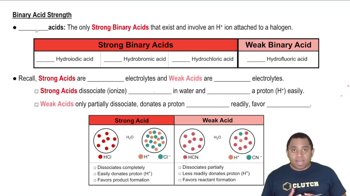Here are the essential concepts you must grasp in order to answer the question correctly.
Acid Strength
Acid strength refers to the ability of an acid to donate protons (H+) in a solution. Stronger acids have a greater tendency to lose protons, resulting in a higher concentration of H+ ions in solution. This property is often quantified using the acid dissociation constant (Ka), where a larger Ka value indicates a stronger acid.
Recommended video:
Resonance Stabilization
Resonance stabilization occurs when a molecule can be represented by multiple valid Lewis structures, allowing for the delocalization of electrons. In the context of acids, resonance can stabilize the conjugate base formed after the acid donates a proton. The more stable the conjugate base, the stronger the corresponding acid, as it favors the dissociation of protons.
Recommended video:
Inductive Effect
The inductive effect refers to the electron-withdrawing or electron-donating effects of substituents attached to a molecule. Electron-withdrawing groups can increase acid strength by stabilizing the negative charge on the conjugate base, while electron-donating groups can decrease acid strength. Understanding the inductive effects of substituents on benzoic acid and phenol is crucial for predicting their relative acid strengths.
Recommended video:
 Verified step by step guidance
Verified step by step guidance


